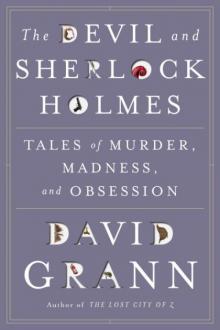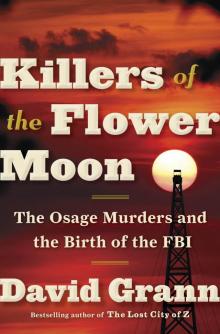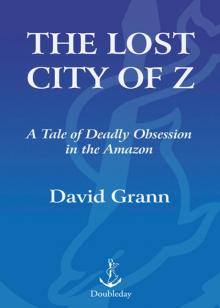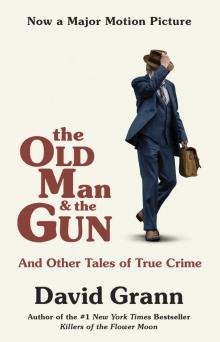- Home
- David Grann
The Old Man and the Gun
The Old Man and the Gun Read online
David Grann
The Old Man and the Gun
David Grann is a staff writer at The New Yorker and the bestselling author of The Lost City of Z and Killers of the Flower Moon, a National Book Award finalist. Both were chosen as best books of the year by The New York Times, The Washington Post, and other publications. Grann is also the author of the essay collection The Devil and Sherlock Holmes. His work has garnered several honors for outstanding journalism, including a George Polk Award and an Edgar Award.
www.davidgrann.com
ALSO BY DAVID GRANN
Killers of the Flower Moon: The Osage Murders and the Birth of the FBI
The Lost City of Z: A Tale of Deadly Obsession in the Amazon
The Devil and Sherlock Holmes: Tales of Murder, Madness, and Obsession
FIRST VINTAGE BOOKS MOVIE TIE-IN EDITON, SEPTEMBER 2018
Copyright © 2010 by David Grann
All rights reserved. Published in the United States by Vintage Books, a division of Penguin Random House LLC, New York, and distributed in Canada by Random House of Canada, a division of Penguin Random House Canada Limited, Toronto. These essays are taken from The Devil and Sherlock Holmes, originally published in hardcover in the United States by Doubleday, a division of Penguin Random House LLC, New York, in 2010.
Vintage and colophon are registered trademarks of Penguin Random House LLC.
The pieces in this work first published, in slightly different form, in The New Yorker: “The Old Man and the Gun” on January 27, 2003; “True Crime” on February 11 and 18, 2008; and “The Chameleon” on August 11, 2008.
The Cataloging-in-Publication data is on file with the Library of Congress.
Vintage Books Movie Tie-In ISBN 9780525566038
Ebook ISBN 9780525566069
Cover art © 2018 Twentieth Century Fox Film Corporation. All rights reserved.
Author photograph © Matt Richman
www.vintagebooks.com
v5.3.2
ep
Contents
Cover
About the Author
Also by David Grann
Title Page
Copyright
The Old Man and the Gun
True Crime
The Chameleon
The Old Man and the Gun
THE SECRETS OF A LEGENDARY STICKUP MAN
Just before Forrest Tucker turned seventy-nine, he went to work for the last time. Although he was still a striking-looking man, with intense blue eyes and swept-back white hair, he had a growing list of ailments, including high blood pressure and burning ulcers. He had already had a quadruple bypass, and his wife encouraged him to settle into their home in Pompano Beach, Florida, a peach-colored house on the edge of a golf course which they’d purchased for their retirement. There was a place nearby where they could eat prime rib and dance on Saturday nights with other seniors for $15.50 a person, and even a lake where Tucker could sit by the shore and practice his saxophone.
But on this spring day in 1999, while his neighbors were on the fairway or tending to their grandchildren, he drove to the Republic Security Bank in Jupiter, about fifty miles from his home. Tucker, who took pride in his appearance, was dressed all in white: white pants with a sharp crease, a white sports shirt, white suède shoes, and a shimmering white ascot.
He paused briefly in front of the A.T.M. and pulled the ascot up around his face, bandit style. He then reached into a canvas bag, took out an old U.S. Army Colt .45, and burst into the bank. He went up to the first teller and said, “Put your money on the counter. All of it.”
He flashed the gun so that everyone could see it. The teller laid several packets of fives and twenties on the counter, and Tucker inspected them for exploding dye packs. Checking his watch, he turned to the next teller and said, “Get over here. You, too.”
Then he gathered up the thick packets—more than five thousand dollars—and hurried to the door. On his way out, he looked back at the two tellers. “Thank you,” he said. “Thank you.”
He drove to a nearby lot, where he had left a “safe” car, a red Grand Am that couldn’t be traced to him. After wiping down the stolen “hot” car with a rag, he threw his belongings inside the Grand Am. They included a .357 Magnum, a sawed-off .30 carbine, two black nylon caps, a holster, a can of Mace, a pair of Smith & Wesson handcuffs, two rolls of black electrical tape, a police badge, five AAA batteries, a police scanner, a glass cutter, gloves, and a fishing cap. There was also a small bottle of medicine for his heart. No one seemed to notice him, and he went home, making what appeared to be a clean getaway.
After a brief stop to count the money, he got back in the car and headed out again. As he approached the golf course, the bills neatly stacked beside him, he noticed an unmarked car on his tail. He turned onto another street, just to make sure. There it was again. Then he spotted a police car pulling out behind him. He hit the gas as hard as he could, trying to outmaneuver them, turning left, then right, right, then left. He went past the North Pompano Baptist Church and the Kraeer Funeral Home, past a row of pink one-story houses with speedboats in the driveways, until he found himself on a dead-end street. As he spun around, he saw that a police car was barricading the road. One of the officers, Captain James Chinn, was reaching for his shotgun. There was a small gap between Chinn’s car and a wooden fence, and Tucker, his body pitched forward in his seat, sped toward it. Chinn, who had spent almost two decades as a detective, later said he had never seen anything like it: the white-haired figure barrelling toward him seemed to be smiling, as if he were enjoying the showdown. Then, as the car skidded over the embankment, Tucker lost control and hit a palm tree. The air bags inflated, pinning him against the seat.
The police were stunned when they realized that the man they had apprehended was not only seventy-eight years old—he looked, according to Chinn, “as if he had just come from an Early Bird Special”—but one of the most notorious stickup men of the twentieth century. Over a career that spanned more than six decades, he had also become perhaps the greatest escape artist of his generation, a human contortionist who had broken out of nearly every prison he was confined in.
One day in 2002, I went to meet Tucker in Fort Worth, Texas, where he was being held in a prison medical center after pleading guilty to one count of robbery and receiving a thirteen-year sentence. The hospital, an old yellow brick building with a red tiled roof, was on top of a hill and set back off the main road, surrounded by armed guards and razor wire. I was handed a notice that said no “weapons,” “ammunition,” or “metal cutting tools” were allowed, and then escorted through a series of chambers—each door sealing behind us before the next one opened—until I arrived in an empty waiting room.
Before long, a man appeared in a wheelchair pushed by a guard. He wore brown prison fatigues and a green jacket with a turned-up collar. His figure was twisted forward, as if he had tried to contort it one last time and it had frozen in place. As he rose from the wheelchair, he said, “It’s a pleasure to meet you. Forrest Tucker.”
His voice was gentle, with a soft Southern lilt. After he extended his hand, he made his way slowly over to a wooden table with the help of a walker. “I’m sorry we have to meet here,” he said, waiting for me to sit first.
Captain Chinn had told me that he had never met such a gracious criminal: “If you see him, tell him Captain Chinn says hi.” Even a juror who helped convict him once remarked, “You got to hand it to the guy—he’s got style.”
“So what do you want to know?” Tucker sai
d. “I’ve been in prison all my life, except for the times I’ve broken out. I was born in 1920, and I was in jail by the time I was fifteen. I’m eighty-one now and I’m still in jail, but I’ve broken out eighteen times successfully and twelve times unsuccessfully. There were plenty of other times I planned to escape, but there’s no point in me telling you about them.”
As we sat in a corner by a window overlooking the prison yard, it was hard to imagine that this man’s career had featured wanted posters and midnight escapes. His fingers were knotted like bamboo, and he wore bifocals.
“What I mean by a successful escape is to elude custody,” he continued, squinting out the window. “Maybe they’d eventually get me, but I got away at least for a few minutes.”
He pointed to the places along his arm where he had been shot while trying to flee. “I still have part of a bullet in me,” he said. “They all opened up on me and hit me three times—in both shoulders with M16 rifles, and with buckshot in the legs.”
His voice sounded dry, and I offered to buy him a drink from the vending machine. He followed me and peered through the glass, without touching it. He chose a Dr Pepper. “That’s kind of like cherry soda, isn’t it?”
He seemed pleased. When I gave him the drink, he glanced at the candy bars, and I asked him if he wanted anything else. “If it’s not too much trouble,” he said, “I’d like a Mounds.”
After he finished eating, he began to tell me what he called “the true story of Forrest Tucker.” He spoke for hours, and when he grew tired he offered to continue the next morning. During our conversations, which went on for several days, we always sat in the corner by the window, and after a while he would cough slightly and I would offer to buy him a drink. Each time, he followed me to the machine, as the guard watched from a distance. It was only during the last trip to the machine, when I dropped some money, that I noticed his eyes were moving over everything—the walls, the windows, the guard, the fences, the razor wire. It occurred to me that Tucker, escape artist par excellence, had been using our meetings to case the joint.
* * *
—
“The first time I broke out of the can I was only fifteen,” Tucker told me. “At fifteen, you’re pretty fast.”
It was the spring of 1936, and he had been incarcerated for stealing a car in Stuart, Florida, a small town along the St. Lucie River which had been devastated during the Depression. He told the police that he took it “just for a thrill,” but as he sat in jail the thrill gave way to panic, and when a jailer removed his chains he darted out. Several days later, a deputy discovered him in an orange grove, eating a piece of fruit. “That was escape No. 1,” Tucker says. “Such as it was.”
The sheriff decided to transfer him to reform school. During his brief flight, however, Tucker had slipped a half-dozen hacksaw blades through the cell window to a group of boys he had met inside. “They hadn’t broken out yet and still had the blades,” he says. That night, after sawing a bar, he slithered out, helping two other boys squeeze through the tiny opening.
Unlike the others, Tucker knew the area. As a kid, he had spent a fair amount of time by the river, and it was in the river that the police found him and another boy, about an hour later, hiding with just their noses above water. The next day, the Stuart Daily News detailed his exploits under the headline “TRIO ESCAPE BY SAWING BARS OF CELL LAST NIGHT…SUPPLIED WITH HACK-SAWS, COLD CHISELS AND FILES BY BOY.”
“That was escape No. 2,” Tucker says. “A brief one.”
Like the outlaws he read about in dime novels who were forced into banditry by some perceived injustice, Tucker says that “the legend of Forrest Tucker” began on the morning when he was unfairly sent away for only a minor theft. The story, which he repeated even as a boy, eventually spread throughout the town, and over time the details became more ornate, the theft more minor. Morris Walton, who used to play with Tucker as a child, says, “My sense is he spent his life in jail for stealing a bicycle and simply trying to escape. If he became bad, it was only because the system made him that way.”
What Walton knew of Tucker’s upbringing reinforced that impression. His father was a heavy-equipment operator who disappeared when Tucker was six. While his mother struggled in menial jobs in Miami, Tucker was sent to live with his grandmother, who was the tender of the bridge in Stuart. There he built canoes and sailboats out of scrap metal and wood, which he gathered along the riverbank, and taught himself to play the saxophone and the clarinet. “It wasn’t like I needed a father to order me around,” he says.
But as his reputation for cleverness grew, so did his rap sheet. By his sixteenth birthday, it included charges of “breaking and entering” and “simple larceny.” After he escaped from reform school and fled to Georgia, he was sentenced to “be placed and confined at labor in the chain gang.” Like all new inmates, he was taken to the blacksmith, where a chain was riveted around both of his ankles. The steel gradually ate into the skin, a condition known as shackle poisoning.
“The guards would give you the first three days to let you get your hands broken in with calluses,” Tucker recalls. “But after that the walking boss would punish you, hit you with his cane or fist. And if you didn’t work hard enough the guards would take you in the bathroom and tie your hands behind your back and put a pressure hose in your face and hold it there until you’d sputter and you couldn’t breathe.”
Although Tucker was released after only six months, he was soon convicted again, for stealing another car, and sentenced to ten years. By now, “we see a man who has been thoroughly cast out by society,” Tucker’s lawyer later wrote in a court motion. “Marked as a criminal at seventeen years old and constantly railroaded through judicial proceedings without the benefit of counsel, Forrest Tucker was becoming an angry young man.” Tucker himself says, “The die was cast.” In photographs taken after he was paroled at the age of twenty-four, his hair is cut short and he has on a white T-shirt; his once slender arms are coiled with muscles. His eyes are piercing. People who knew him say that he was extraordinarily charismatic—that girls flocked around him—but they also noted a growing reservoir of anger. “I think he had this desperate need to show the world that he was somebody,” one of his relatives says.
At first, Tucker sought work playing the saxophone in big bands around Miami, and he seemed to have harbored ambitions of becoming another Glenn Miller. Nothing came of it, though, and, after a brief failed marriage, he put away his sax and got himself a gun.
* * *
—
The outlaw, in the American imagination, is a subject of romance—a “good” bad man, he is typically a master of escape, a crack shot, a ladies’ man. In 1915, when the police asked the train robber Frank Ryan why he did it, he replied, “Bad companions and dime novels. Jesse James was my favorite hero.”
When Tucker was growing up, during the Great Depression, the appeal of bank robbers, fuelled by widespread anger over defaults and foreclosures, was reaching its zenith. After the F.B.I. gunned down John Dillinger, in 1934, droves descended on the scene, mopping up his blood with their clothes. At least ten Hollywood films were devoted to Dillinger’s life; one of them exclaimed, “His Story Is Written in Bullets, Blood and Blondes!”
Because the holdup demands a public performance, it tends to draw a certain personality: bold, vainglorious, reckless. At the same time, most bank robbers know that the society that revels in their exploits will ultimately demand their elimination, by incarceration or death. “They’ll get me,” Pretty Boy Floyd once said. “Sooner or later, I’ll go down full of lead. That’s how it will end.”
Indeed, by the time Tucker set out to become an outlaw, in the late nineteen-forties, most of the legendary stickup men had already been gunned down. Still, he began to imitate their style, dressing in chalk-striped suits and two-tone shoes, and he would stand in front of a mirror, pointing a gun at his own reflection. Fina
lly, on September 22, 1950, with a handkerchief tied over his face and a gun drawn in the style of Jesse James, he strode into a bank in Miami and made off with $1,278. A few days later, he went back to the same place, this time for the entire safe. He was apprehended as he was trying to crack it open with a blowtorch on the roadside.
His career seemed even more fleeting than that of most bank robbers, but in the county jail Tucker decided he was more than an ordinary stickup man. “It didn’t matter to me if they gave me five years, ten years, or life,” he says. “I was an escape artist.”
He searched the prison for what he called “the weak spot.” One day around Christmas, after weeks of looking, he began to moan in pain. The authorities rushed him to the hospital, where doctors removed his appendix. (“A small price to pay,” Tucker says.) While convalescing, still chained to his bed, he started to work on the shackles. He had taught himself how to pick a lock using almost anything—a pen, a paper clip, a piece of wire, nail clippers, a watch spring—and after a few minutes he walked out, unnoticed.
He made his way to California, where he went on a spree of robberies, hurtling over counters, pointing his gun, and declaring, “I mean business!” He wore bright checkered suits and sped away in a flamboyant getaway car with tubes along the sides. He even talked like a character in pulp fiction. “This is a stickup, girls,” he once said, according to witnesses. “I’ve got a gun. Be quiet and you won’t get hurt.”
Hoping to improve his take, Tucker began to cast about for a partner. “I didn’t want any nuts or rats,” he says, adding, “I’m from the old school.” In the end, he found an ex-con named Richard Bellew, a tall, handsome thief with a high I.Q. and wavy black hair. Like Tucker, Bellew modelled himself on the stickup men of the nineteen-thirties, and he ran with a stage dancer named Jet Blanca. But Tucker chose him for another reason: “He always let me count the dough.”

 The Devil & Sherlock Holmes: Tales of Murder, Madness & Obsession
The Devil & Sherlock Holmes: Tales of Murder, Madness & Obsession Killers of the Flower Moon
Killers of the Flower Moon The Lost City of Z
The Lost City of Z The Old Man and the Gun
The Old Man and the Gun